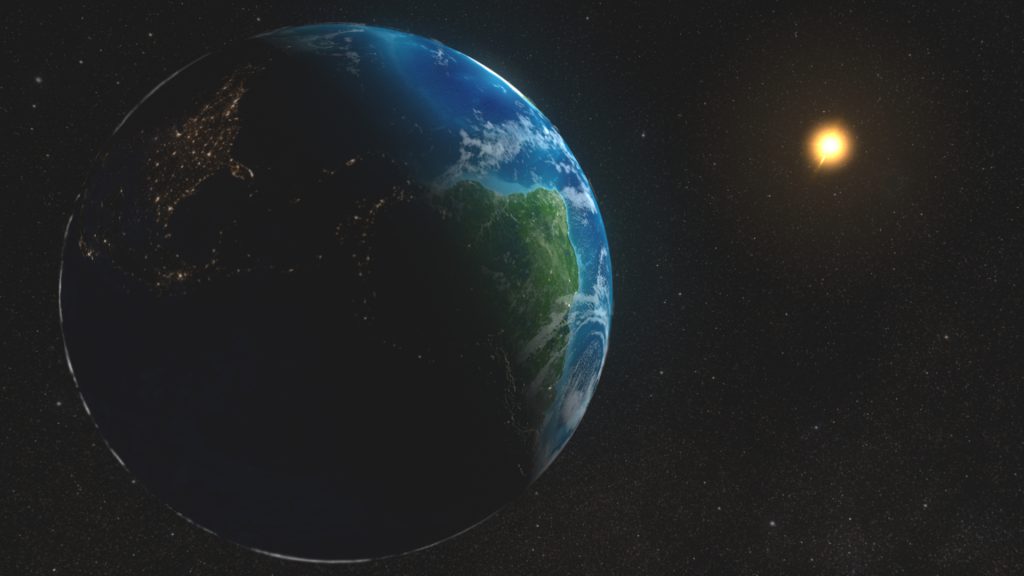

The conditions that keep the Earth’s climate livable are well known. The Earth orbits the Sun. Light from the Sun falls on the Earth; some passes through the atmosphere and warms the surface of the Earth. Gravity keeps Earth’s atmosphere from drifting off into space, and a mix of GHGs (e.g., water vapor, CO2, methane, ozone and others) trap heat close to the surface because of the greenhouse effect. It is warmer in Chicago than on the Moon because Earth’s atmosphere blankets the planet and keeps energy near the surface of the planet.
Anything that causes the amount of energy trapped by the atmosphere to go up or down over long periods of time changes the climate. Some of these climate agents are well known and familiar. For example, more sunshine means warmer surface temperatures and more heat for greenhouse gases to keep near the surface. It feels warmer in Miami than in Chicago, in part, because places near the equator get more sunlight.

Image Courtesy of National Academies of Sciences, Climate Change: Evidence and Causes
Over any particular epoch in Earth’s history, the combination of factors determining the climate or causing it to change has varied. Long-term changes in the brightness of the Sun, the shape of the orbit of the Earth around the Sun, the distribution of the continents, the reflectivity of the land surface, eruptions of large volcanoes, and the chemical composition of the atmosphere are all known to have affected the climate. Over Earth’s history, changes in these primary drivers of climate have led to conditions drastically different from today—both colder and hotter.
Much of the challenge of climate science comes in discerning how these different effects have accentuated or offset each other. For example, what is the ultimate effect of increasing the solar output of the Sun (warming), making the Earth’s surface brighter by deforestation (cooling), and intensifying the greenhouse effect (warming) when all occur together? In most cases, the interactions between these factors make their relationships with global climate too difficult to understand through simple qualitative analysis. This is why scientific and quantitative analysis is important.
Developing a scientific understanding of the climate of the last 800,000 years is an example of the challenge of figuring out the relative importance of different climate drivers. During that period the climate cycled naturally between cold ice ages and warm periods at irregular intervals lasting thousands of years. Figure 1 shows temperatures near the South Pole changed by as much as 10 °C between cold glacial periods and warmer interglacial periods. The corresponding global temperature changes were about half that, on the order of 4-6°C.

The co-evolution of temperature and CO2 concentration from the last 800,000 years. The temperature record in red captures the air temperature in Antarctica by measuring the ratio oxygen isotopes trapped in air bubbles taken from ice formed in the deep past. CO2 levels are measured from the same air bubbles and are shown in blue. The rapid increase of atmospheric CO2 in the recent past is shown as a dotted blue line. Source: United States National Academies of Sciences, Climate Change: Evidence and Causes
As the climate moved between hot and cold periods, the atmospheric CO2 concentration also went up and down. This clear relationship in measurements prompted scientists to ask whether CO2 was driving temperature changes, or whether temperature changes were driving CO2 concentrations.
Research has revealed that both are true. Scientists found that the increase in CO2 concentrations followed temperature changes, indicating something else must be contributing. The leading explanation now holds that temperature changes from wobbles in the Earth’s orbit caused warming, which increased CO2 levels and caused additional warming. To exit each ice age, changes in Earth’s orbit tipped the ice-covered Northern Hemisphere toward the sun, causing ice to melt at the poles, the surface reflectivity to decrease, and global temperatures to increase. CO2 was then released into the atmosphere from the warmer oceans, which hold a lot of dissolved carbon. The warming effect of increased CO2 helped give warm periods an extra temperature boost. As geological time wore on, changes in the orbit of the planet favored cooling and the released CO2 was eventually recaptured by the oceans. Cooling at high Northern latitudes led to ice formation, and again the world fell into an ice age.
wobbles: These wobbles are really changes in three distinct orbital parameters that together determine how sunlight falls on the Earth: the circularity of the planet’s orbit, the tilt of Earth’s axis with respect to the Sun, and the time of year when Earth is closest to the Sun.